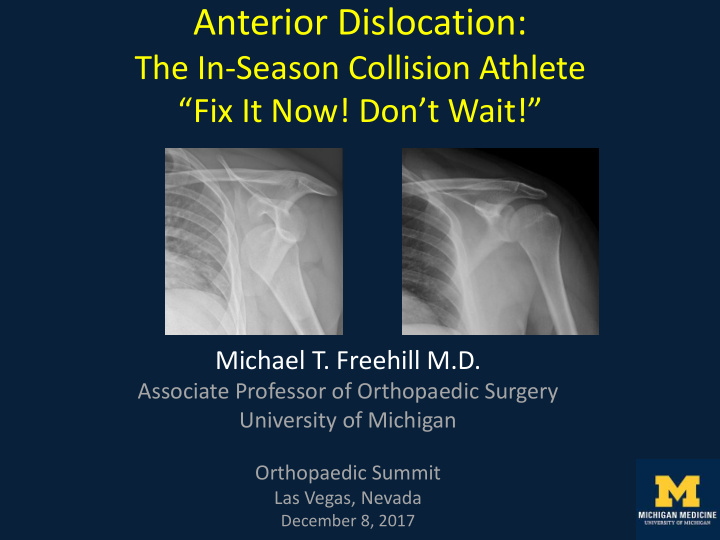



Anterior Dislocation: The In-Season Collision Athlete “Fix It Now! Don’t Wait!” Michael T. Freehill M.D. Associate Professor of Orthopaedic Surgery University of Michigan Orthopaedic Summit Las Vegas, Nevada December 8, 2017
Disclosures Consultant for Smith and Nephew Research support: Smith & Nephew Committee member : AAOS, ASES, ISKAOS, AOSSM
What to do? • First time dislocator • In-season • Collision athlete Fix It Now!
The Great Dr. Anthony Miniaci • Professor – World expert • Instability – 24 Peer Reviewed PubMed
First hand Experience Former Head Team Physician Cleveland Browns
First hand Experience
Robinson et al JBJS 2006
Recurrent Instability Risk • Prospective 25 year follow-up – 12-25y/o at primary dislocation (n=115) – 50% had not redislocated or became stable over time – Concluded: prognosis for younger ages, neither very good or very bad – Unnecessary surgeries in 30-50% Hovelius et al. JBJS 2008
Fixing it now is right thing to do! • Need to change antiquated views! • Need to debunk the myths! • Are we providing the best care for the athlete? or taking the OITE?
Modern Suture Anchor Technique: Arthroscopic Recurrence AJSM 2006 • Carreira et al. 10% AJSM 2010 • Castgana et al. 23% • Voos et al. AJSM 2010 18% • Van der Linde et al. AJSM 2011 35% • Ozturk et al. Arth 2013 13% • Aboalata et al. AJSM 2016 18%
Age and Gender • 22 years or younger and male: Recurrence – Porcellini et al. JBJS 2009 13% – Voos et al. AJSM 2010 18% – Castagna et al. Arth 2012 21% – Gigis et al. JPO 2014 13% (Failure rate after arthroscopic primary Bankart repair)
AJSM 2006 37% “at least 1” additional episode during season
Buss et al. AJSM 2006 • Tolerance • Restricted motion • Sport specific tasks – position
JAAOS 2012 • Controversy exists • Limited data to guide treatment
AJSM 2014 45 intercollegiate athletes Only 27% completed season without recurrence
19/24 Instability “arthroscopic stabilization may afford better Manuscripts: disease-specific quality of life than taking a wait- and-see approach” Recurrent Instability Bone Defects
Identified Risk Factors for Recurrent Instability • Age • Ligamentous laxity • Poor tissue quality • Contact/collision sports • Delay from initial injury to surgery • Number of pre-op dislocations • Bone loss
Myths • We can get you through season • A brace will protect you • Worse case- recurrent subluxation/dislocation – Going to have surgery at end of season anyway • The damage was already done • It won’t change what I’m going to do
Wait until the end of the season: “Let them experience another dislocation” • Articular surface lesions -glenoid, humeral head • Bone defects • Repetitive subfailure strains -capsular and ligament elongation - additional laxity induced with recurrence Pollack et al, JSES 2000 Urayama, Itoi AJSM 2003 Buscayret, Szabo, Walch, et al AJSM 2004
Tissue Trauma: Longitudinal Studies • Urayama, Itoi AJSM 2003 – MR study showing progressive capsular elongation with recurrence – Anteroinferior 19% elongation with recurrence • Pollack, Owens, Flatow, Bigliani JBJS 2000 – Capsular elongation with repetitive dislocation
Cumulative Soft Tissue Trauma Early Late Courtesy Rick Ryu MD
Conclusion: In-Season Collision Athlete “Waiting To Do Surgery” • Jeopardize tissue quality – Increasing ligamentous laxity – Increasing risk of recurrence post-stabilization • Articular lesions • Potential bone loss • Frustration
Thank you
Recommend
More recommend